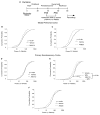Permanent suppression of cortical oscillations in mice after adolescent exposure to cannabinoids: receptor mechanisms
- PMID: 25036610
- PMCID: PMC4188721
- DOI: 10.1016/j.neuropharm.2014.07.006
Permanent suppression of cortical oscillations in mice after adolescent exposure to cannabinoids: receptor mechanisms
Abstract
Marijuana use in adolescence, but not adulthood, may permanently impair cognitive functioning and increase the risk of developing schizophrenia. Cortical oscillations are patterns of neural network activity implicated in cognitive processing, and are abnormal in patients with schizophrenia. We have recently reported that cortical oscillations are suppressed in adult mice that were treated with the cannabinoids WIN55,212-2 (WIN) or Δ(9)tetrahydrocannabinol (THC) in adolescence, but not adulthood. WIN and THC are cannabinoid-1 (CB1R) and CB2R agonists, and also have activity at non-cannabinoid receptor targets. However, as acute WIN and THC administration can suppress oscillations through CB1Rs, we hypothesize that a similar mechanism underlies the permanent suppression of oscillations by repeated cannabinoid exposure in adolescence. Here we test the prediction that cannabinoid exposure in adolescence permanently suppresses cortical oscillations by acting through CB1Rs, and that these suppressive effects can be antagonized by a CB1R antagonist. We treated adolescent mice with various cannabinoid compounds, and pharmacologically-evoked oscillations in local field potentials (LFPs) in vitro in adults. We find that WIN exposure for six days in early adolescence suppresses oscillations preferentially in adult medial prefrontal cortex (mPFC) via CB1Rs, and that a similar CB1R mechanism accounts for the suppressive effects of long-term (20 day) adolescent THC in adult somatosensory cortex (SCx). Unexpectedly, we also find that CB2Rs may be involved in the suppression of oscillations in both mPFC and SCx by long-term adolescent cannabinoid exposure, and that non-cannabinoid receptors may also contribute to oscillation suppression in adult mPFC. These findings represent a novel attempt to antagonize the effects of adolescent cannabinoid exposure on neural network activity, and reveal the contribution of non-CB1R targets to the suppression of cortical oscillations.
Keywords: Development; Marijuana; Neural synchrony; Schizophrenia.
Copyright © 2014 Elsevier Ltd. All rights reserved.
Conflict of interest statement
The authors declare no conflict of interest.
Figures






Similar articles
-
Adolescent cannabinoid exposure permanently suppresses cortical oscillations in adult mice.Neuropsychopharmacology. 2013 Nov;38(12):2338-47. doi: 10.1038/npp.2013.164. Epub 2013 Jul 4. Neuropsychopharmacology. 2013. PMID: 23822952 Free PMC article.
-
Suppression of outward K⁺ currents by WIN55212-2 in rat retinal ganglion cells is independent of CB1/CB2 receptors.Neuroscience. 2013 Dec 3;253:183-93. doi: 10.1016/j.neuroscience.2013.08.056. Epub 2013 Sep 5. Neuroscience. 2013. PMID: 24013008
-
CB1 cannabinoid receptor stimulation during adolescence impairs the maturation of GABA function in the adult rat prefrontal cortex.Mol Psychiatry. 2014 May;19(5):536-43. doi: 10.1038/mp.2014.14. Epub 2014 Mar 4. Mol Psychiatry. 2014. PMID: 24589887 Free PMC article.
-
[Drug discrimination properties and cytotoxicity of the cannabinoid receptor ligands].Nihon Arukoru Yakubutsu Igakkai Zasshi. 2012 Jun;47(3):135-43. Nihon Arukoru Yakubutsu Igakkai Zasshi. 2012. PMID: 22894054 Review. Japanese.
-
Pharmacological and Toxicological Effects of Synthetic Cannabinoids and Their Metabolites.Curr Top Behav Neurosci. 2017;32:249-262. doi: 10.1007/7854_2016_60. Curr Top Behav Neurosci. 2017. PMID: 28012093 Free PMC article. Review.
Cited by
-
Deconstructing the neurobiology of cannabis use disorder.Nat Neurosci. 2020 May;23(5):600-610. doi: 10.1038/s41593-020-0611-0. Epub 2020 Apr 6. Nat Neurosci. 2020. PMID: 32251385 Free PMC article. Review.
-
Long-term hippocampal interneuronopathy drives sex-dimorphic spatial memory impairment induced by prenatal THC exposure.Neuropsychopharmacology. 2020 Apr;45(5):877-886. doi: 10.1038/s41386-020-0621-3. Epub 2020 Jan 26. Neuropsychopharmacology. 2020. PMID: 31982904 Free PMC article.
-
Adolescent Exposure to the Synthetic Cannabinoid WIN 55212-2 Modifies Cocaine Withdrawal Symptoms in Adult Mice.Int J Mol Sci. 2017 Jun 21;18(6):1326. doi: 10.3390/ijms18061326. Int J Mol Sci. 2017. PMID: 28635664 Free PMC article.
-
Cannabinoid CB1 receptor-sensitive neurodevelopmental processes and trajectories.Mol Psychiatry. 2025 Aug;30(8):3792-3803. doi: 10.1038/s41380-025-03057-2. Epub 2025 May 19. Mol Psychiatry. 2025. PMID: 40389627 Free PMC article. Review.
-
Adolescent Δ9-Tetrahydrocannabinol Exposure Selectively Impairs Working Memory but Not Several Other mPFC-Mediated Behaviors.Front Psychiatry. 2020 Nov 12;11:576214. doi: 10.3389/fpsyt.2020.576214. eCollection 2020. Front Psychiatry. 2020. PMID: 33262712 Free PMC article.
References
-
- Andersen SL. Trajectories of Brain Development: Point of Vulnerability or Window of Opportunity? Neurosci Biobehav Rev. 2003;27:3–18. - PubMed
Publication types
MeSH terms
Substances
Grants and funding
LinkOut - more resources
Full Text Sources
Other Literature Sources
Miscellaneous

